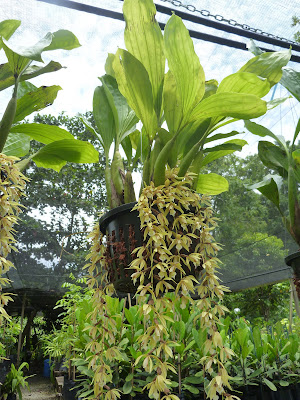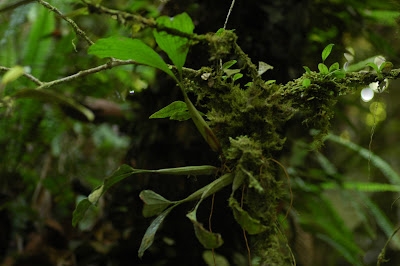Coelogyne rochussenii, also called as Rochussen's Coelogyne is found growing on tree trunks and branches near a water source such as in freshwater...
Coelogyne rochussenii, also called as Rochussen's Coelogyne, Coelogyne macrobulbon, Coelogyne plantaginea, Coelogyne steffiensii, Coelogyne stellaris, Pleione macrobulbon, Pleione plantaginea, Pleione rochussenii, is a species of the genus Coelogyne. This species was described by Willem Hendrik de Vriese in 1854.
IDENTIFY COELOGYNE ROCHUSSENII - ROCHUSSEN'S COELOGYNE
Coelogyne rochussenii is native to Peninsula Thailand to Malesia. It is found growing on tree trunks and branches near a water source such as in freshwater and peat swamp or hill and riverine forests of Borneo, Jawa, Malaya, Maluku, Philippines, Sulawesi, Sumatera, Thailand at elevations of 0-1500 meters above sea level.
It is a medium sized, hot to cool growing epiphyte and occasional lithophyte which reaching up to 60 cm in height with narrowly conical and ribbed pseudobulbs. The green, pleated leaves are oval-shaped with smooth leaf edges and are arranged in pairs on each pseudobulb.
Rochussen's Coelogyne can blooms all year round under cultivation from the basal, heteranthous, to 45 cm long, pendant, racemose, up to 40-flowered inflorescence that arising on a mature pseudobulb. The flowers with yellow sepals and petals have a slight lemon-scent and are open simultaneously.
COELOGYNE ROCHUSSENII - ROCHUSSEN'S COELOGYNE CARE AND CULTURE
Cultural information should only be used as a guide, and should be to be adapted to suit you. Your physical location; where you grow your plants, how much time you have to devote to their care, and many other factors, will need to be taken into account. Only then can you decide on the cultural methods that best suit you and your plants.
Light:
Coelogyne rochussenii needs the light level of 20000-30000 lux. The light should be filtered or dispersed, and the plants should not be exposed to direct sunlight in the afternoon hours. Strong air movement should be ensured all the time.
Temperature:
Throughout the year, the average day temperature is 22-24 ° C, the average night temperature is 13-15 ° C, with an amplitude of daily variations of 7-11 ° C. The hottest days and the coldest nights and thus the largest daily amplitude of the year takes place during a slightly drier period in winter and early spring. If we have a cooling air humidifier, the orchid will grow well close to the cold, humid air outlet.
Humidity:
Rochussen's Coelogyne needs the humidity of 75-80% for most of the year, at the end of winter and early spring, falling to about 60-65%. In a natural habitat, however, the conditions may be slightly more humid.
Too dry air has a negative effect on the development of the plant: its growth is inhibited, and the leaves begin to turn yellow and dry out. The higher temperature, the higher the humidity should be, and the higher the humidity, the more often and longer it is necessary to ventilate the room where the plants are contained, otherwise the probability of rotting and various kinds of fungal diseases.
Substrate, growing media and repotting:
Coelogyne rochussenii grows best attached to pieces of tree fern or cork, but during the summer hot and sunny days it requires high humidity and several waterings during the day. The plants, however, are usually planted in shallow containers or baskets which allow the drooping racemes to hang over the sides (but they do well enough in pots), because for most growers it is difficult to maintain high humidity in the summer planted on rootstocks. The substrate should be loose, quickly draining water, but at the same time it must stop a large part of it, not soaking excessively and not decomposing too quickly. A mixture of chopped tree fern fibers mixed with 10% perlite, 10% cut sphagnum moss and 10% charcoal gives great results for most growers and this medium undergoes very slow decomposition. It is also possible to use a fir bark, if humectants are added, but the constantly moistened bark decomposes quickly and the plants need to be replanted more often.
The plant should be replanted as little as possible, because this shock may even stop flowering for the next three years, which is why slowly decomposing substrates are so desirable. Some believe that as long as the substrate is still loose and well-aerated, it is better to simply cut old, drying pseudobulbs than to replant the plant. However, if replanting is necessary, it is best to do it when new roots begin to grow. This will allow the plant to adapt to the new substrate in the shortest possible time.
Watering:
For most of the year, rainfall is intense and only slightly diminishes within 2-3 months of the semi-dry period at the end of winter and early spring. During intensive growth, cultivated plants should be abundantly watered, but the substrate should not be allowed to spread or become damp. In late autumn, watering should be limited.
Watering is directly dependent on the temperature of the content, the higher it is, the more often it needs to be watered. When watering, excess water should flow freely from the pot, since stagnation of water both inside the pot and in its pan can very quickly lead to rotting of the roots and the lower part of the plant.
Fertilizer:
During the active growth, Rochussen's Coelogyne should be fertilized every week 1/4-1/2 of the recommended dose of fertilizer for orchids. Many breeders prefer to use sustainable fertilizer throughout the year, but there are also those who use fertilizer with increased nitrogen content from spring to mid summer, and then, in late summer and autumn, begin using a fertilizer with a higher content of phosphorus.
In order to avoid the accumulation of mineral deposits during the period of strong fertilization, it is recommended to rinse the containers approximately every month. Flushing is especially important where the water is highly mineralized. First, normally, the plant should be watered to dissolve the accumulated salts, and after about an hour, rinse the substrate with water equal to twice the volume of the container.
Rest period:
Fluctuations in temperatures throughout the year are small, so they should be maintained throughout the year at the level of the summer growing season. In winter, rainfall in the natural habitat is slightly lower, but additional moisture provides abundant dew and fog, so the plants do not remain without water for a long period of time. Watering in winter should be reduced to a certain extent, especially in the case of plants cultivated in darker conditions of a short day typical of higher latitudes, but they should not completely dry up. In general, between occasional watering, occasional fogging is enough in the early morning, twice less often than in the summer. Fertilization should be reduced or eliminated until new growths appear and a more abundant spring watering begins.















COMMENTS